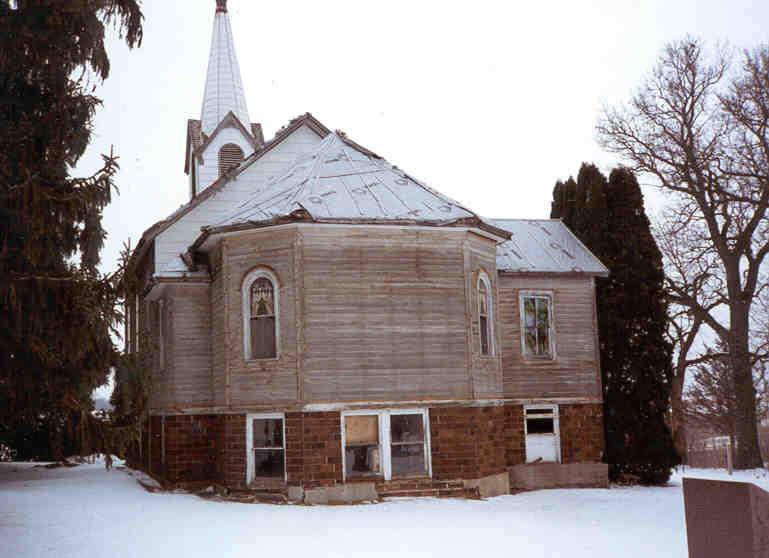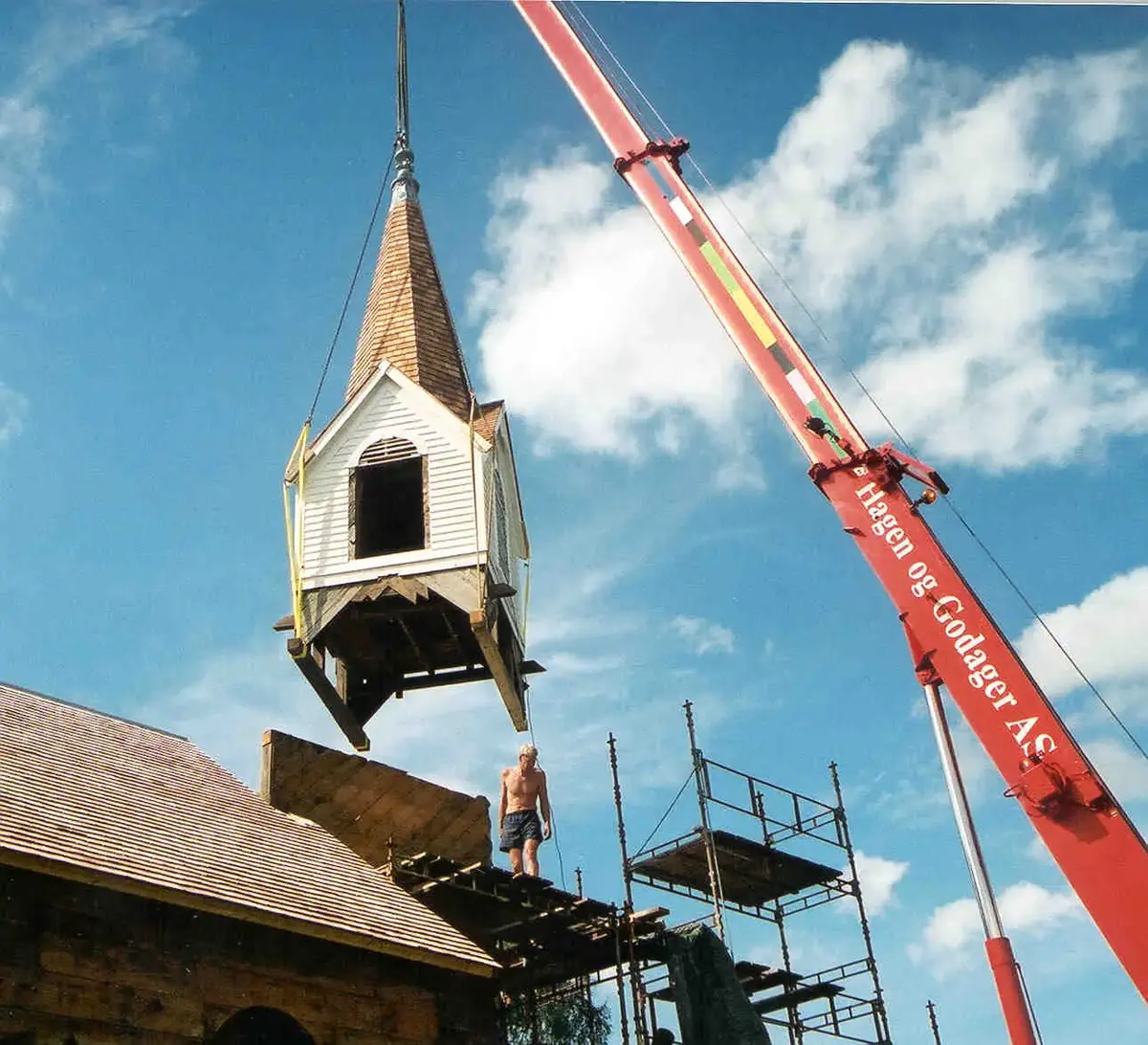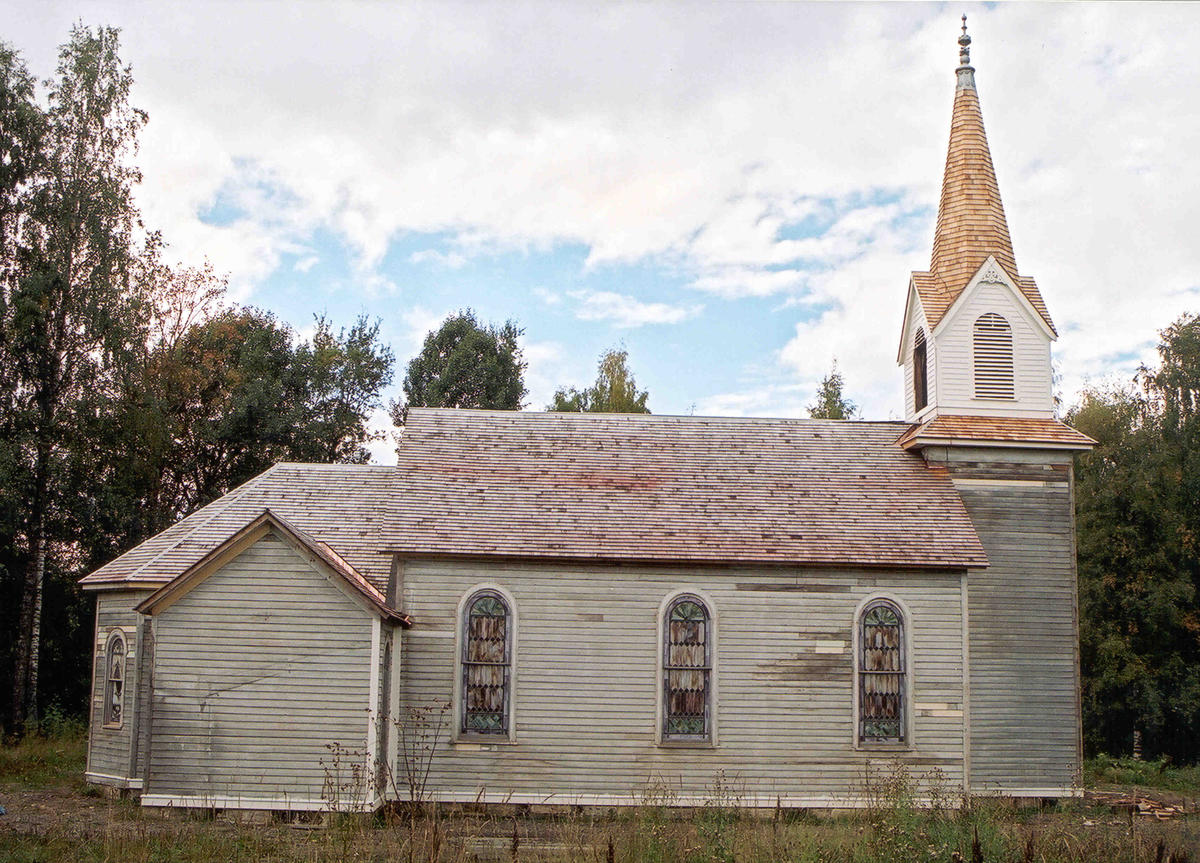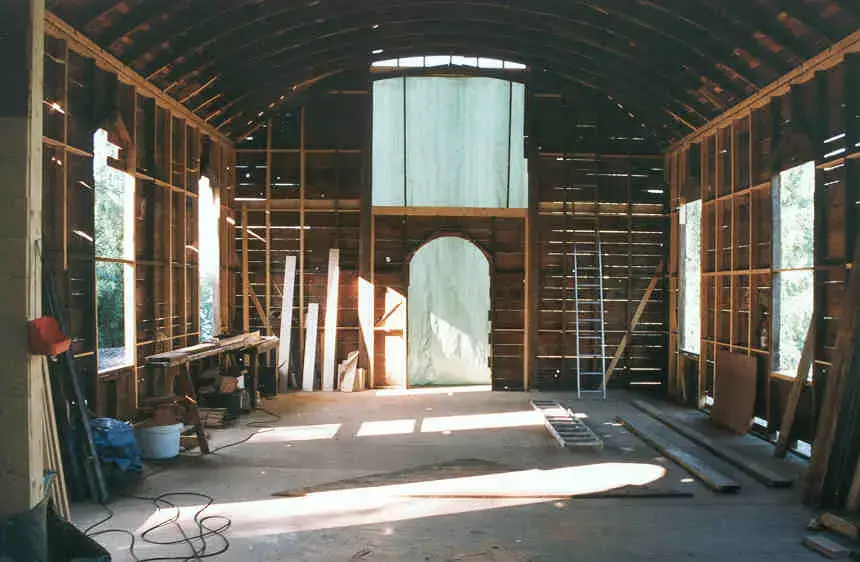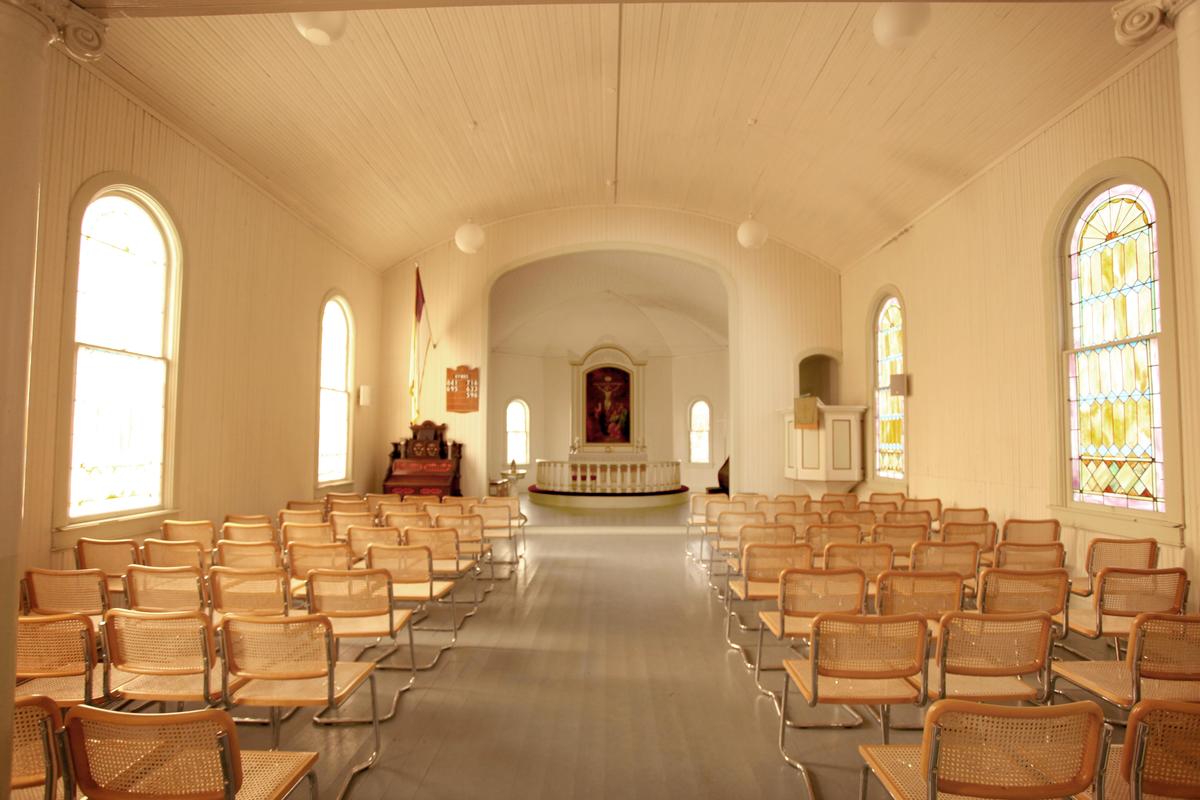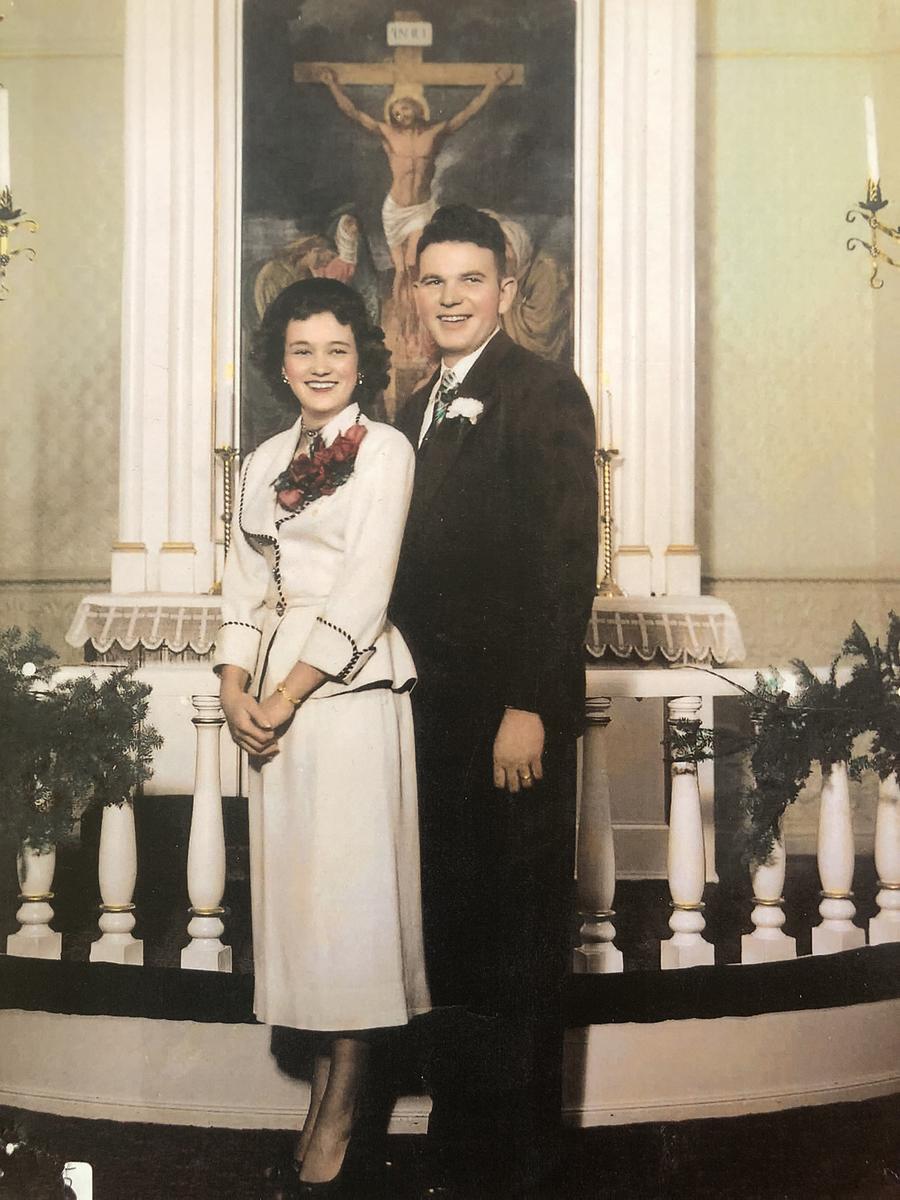- 1/1
Churches were central elements in the lives of the Norwegian settlers in America, both as religious and social meeting places. Oak Ridge Lutheran Church, as it was originally named, was built in 1896 by the Norwegian Ole Haraldson. The Church was built on a ridge outside of the city of Houston in southeast Minnesota.
History
In 1854, a congregation was created in Highland Prairie, a town in southeastern Minnesota. In 1865, they built their own church. Later – in 1888 – eight families left this congregation and founded their own, namely Oak Ridge. They retained the same pastor, but it is believed that they wanted to have their own congregation closer to where they lived. In the beginning, services were held in the schoolhouse. But in 1896, this church was built. They were able to buy leaded glass windows from the nave, the altar, the baptismal font and the church bell from the original church which had since been rebuilt. Ole Haraldsen, originally from Telemark, was in charge of the construction.
Three pastors served the Norwegian congregation. Rev Kristian Magelssen 1896-1914, Rev. Nils Magelssen 1914-1949 and Rev. Isak Gronlid 1949-1967.
Throughout the 1950s and 60s, church membership dwindled and in 1967, the congregation dissolved. Nevertheless, the cemetery is still being maintained. The church stood empty from 1967 until the parish council donated it to the museum in 1992.
The altar painting had, fortunately, been taken care of by a member of the parish council, who had saved it coiled under her bed throughout the years. It had received quite a battering, but was restored by the Painting Conservatory at Maihaugen.
Today, the church is used for church services, marriages, concerts, and other cultural events.
The building
The church initially consisted of only the nave and the choir. Then a little bell tower was built on the roof of the nave. When the church was dismantled and taken down in order to move it to the museum, we found a ceiling board with marks from the bell rope.
The belfry was most likely built in 1908. The year was painted with green paint on the inside of the belfry. The belfry was built loosely and bolted solidly to the church with three large bolts on each side. It is also believed that, in 1908, the church got a new choir. The opening was sawed out by hand, - the tracks of the saw are visible- and the new choir, such as it is today, was extended. The old choir was then moved and used as a vestry.
In the 1930s, the whole church was jacked up and a basement was built underneath, which functioned as a kind of society house or local meeting place. In America, there was no state church, - the church had to earn their own money. They rented out the basement and held various activities in the basement, which were alternative ways of acquiring funding.
The church interior has not always looked as it does now. In the beginning, the walls were dark brown woodwork and the ceiling was light blue. At one point in the 1930s, the interior walls got a covering of painted punched tin plates, as was the fashion at that time.
These tin plates were, unfortunately, in such bad condition that they could not be put up again. They had rusted so that the walls underneath also were very ugly. Therefore, the walls were repainted. The color was picked out from the colors of the painted tin plates.
When the congregation was dissolved, much of the interior was sold by auction. Fortunately, rumors went around that the church had been moved and rebuilt in Norway. Soon, the Bible, the chorale book, the green cloths from the altar, the pulpit, and the baptismal font were returned. The church benches had also been sold and only one original bench remained.
Timeline
The sources are the minutes of the Oak Ridge church’s annual meeting, newspaper articles, personal correspondence in the museum’s archives and personal experience.
1854 - A Norwegian-American church congregation is founded by Highland Prairie in proximity to Bratsberg, a little settlement with many Norwegian immigrants in southeast Minnesota.
1865 - The first Norwegian-American church by Highland Prairie is finished.
1869 - Pastor Kristian Magelsson (1839-1921) becomes pastor at the church.
1887, 31 July - Eight families in the Highland Prairie congregation decide to create their own congregation at the schoolhouse under the name “Maloney Congregation”. Kristian Magelsson is pastor of Highland Prairie and Maloney.
1895, 3 March - “The first Congregational Meeting at Oak Ridge”. The congregation receives the name: “Oak Ridge Norwegian Evangelical Lutheran Congregation of Houston County, Minnesota”. At approximately the same time, the “Maloney Congregation” is disbanded. A plot on approximately one half acre is bought. Ole Haraldson, H. Ekre, and A. Anderson are commissioned to get stones for the church’s foundation wall and get the wall finished by October 10th . The meeting decides that the church should be built: “34 feet long, 26 feet wide and 14 feet high”.
The minutes of the congregation’s annual meetings are written in Norwegian.
1895, 24 April – The “Ladies Aid” is established. With time, the activities of the “Ladies Aid” become the most reliable and largest single source of income for the congregation.
1896, 23 February - The congregation decides to get started with the church building. Ole Haraldsen is commissioned to build the church, for a price of $1.75 per day. The congregation also hires a second carpenter, Ole Nygaard.
The congregation also decides that the church:
● Should have three windows on each side, and the windows should be eight feet high;
● Should have a double door on the front end;
● Should have a choir on the back end of the church that should be ten feet wide, twelve feet long and ten feet high, with a window on every side;
● Should have a belfry, six feet “square” with a high spire.
It is decided that: “The building committee will attempt to purchase from the Highland Prairie Congregation whatever inventory from the Old Church that can be used.” It included, among other things, the windows, the altar, the baptismal font, and the church bell.
The eight families that had stood behind the Maloney congregation since 1887 became formally enrolled as the first members of the new Oak Ridge congregation.
1897, 18 July - The church is consecrated for the first time. Kristian Magelsson is formally called as the pastor of Oak Ridge.
1903 - It is decided that “a little house” that stood by the church should get a new foundation wall. It will also be dressed and painted inside. Likely, this was the church’s “outhouse”. The house later was removed, date unknown.
1904 - The congregation votes “to buy an organ from Moen for $71.00 if one, after testing it, finds it acceptable.”
1908 - The congregation builds a bell tower on the outside of the old nave. The price is $446.38. A gallery is built inside the church along with a new choir loft. The old choir is turned ninety degrees and is added to the building as a vestry. The pulpit is moved and a little room behind the pulpit is built.
1910 - The congregation decides to hold a Norwegian religion school for two months during the summer. It is unknown when the congregation discontinued the school.
1914 - Nils Stokfleth Magelsson (1880-1960) takes over as pastor after his father.
1922 - 1926 - The church building including the belfry, the nave, the choir, and the vestry, is jacked up almost two meters. A proper basement is built with the correct height and a molded floor through the whole church. The building is jacked down again.
This was possibly the time period when the whole interior - even the ceiling - is dressed with punched steel plates, a style which was normal at that time in public places of assembly, i.e. club houses, stores, and food places.
1924 - Starting from the annual meeting in 1924, the congregation’s accounts are kept in English. The minutes of the annual meeting are still kept in Norwegian.
1928 - 1930? - The church congregation is at its largest with about 75 members. From December 13th, 1928, minutes of the annual meeting are kept in English.
1930, December 11th - The congregation decides that every other church service will be in English.
1939 - The Ladies Aid establishes a Sunday school. This is probably done because the congregation no longer has the capacity to hold a Norwegian-speaking religion school at the church.
1944, December 14th - The congregation votes: “after prayer from the woman Muhle who is not so good at English, a Norwegian-speaking church service will be held every once and a while.”
1947 - The church is renovated. A coal-fired oven is put in. Later, an oil-fired oven will be installed. The whole outside is dressed in asbestos sheets. It is possible that it is at this point in time that the church gets water and drainage.
1949 - Isak R. Gronlid (1897-1979) succeeds Nils S. Magelsson as pastor of the congregation.
1965 - The last confirmation in the church. “Oak Ridge Cemetery Association” is established to preserve the graveyard around the church. The ownership of the church, the plot of the church, the graveyard, and other property is transferred from the congregation to the “Oak Ridge Cemetery Association”, which thereafter becomes the church’s successor.
1966 - Last baptism, marriage, communion, and burial at Oak Ridge.
1967, May 25th - The members of the congregation vote unanimously to discontinue the congregation beginning January 1st, 1968.
1967, June 1st - Isak Gronlid retires as priest, but promises to finish out the year with one church service a month.
1967, December 20th - Last church service in the church at Oak Ridge.
1967, December 30th - Last meeting of the congregation at Oak Ridge.
1968, June 20th - Auction of the congregation’s assets, including church benches.
1973, Good Friday - The church bell is stolen. Later, it is found again and given to the Highland Prairie church, where it is located today.
1992, March - Director Knut Djupedal visits the church and decides that he will try to get it to Norway. “The Oak Ridge Cemetery Association” gives the church to the museum.
1994 - 1997 - The church is dismantled. The steel plates in the interior must be thrown away. The exterior asbestos cladding is thrown away. The original cladding of wood looks to be in astonishingly good condition. The original door to the vestry also becomes visible. The dismantling is done by Brian Betteridge, Decorah, Iowa, and his staff.
The rose pattern windows in the choir loft are restored in a workshop in Decorah. The other windows do not need restoring. They are packed and sent to Norway. At their arrival, they are almost 140 years old and still just as good.
1998 - The church arrives to Norway in two containers.
1999 - 2002 – The church is rebuilt at the museum plot in Åkershagan. The whole project from the beginning to the end is supported economically by Ralph Engelstad, O. Jay and Pat Tomson, «The Norwegian Emigrant Museum , Inc.» by Christian and Betsy Skjervold, the Nordmanns-Forbundet and many individuals in Norway and the United States. The project is headed by Brian Betteridge from Decorah and Sigurd Fuglseth from Stange.
Many original objects from the church that were sold through auctions in 1976, were donated to the museum, among others the baptismal font.
The altar board is restored by the restoration workshop at Maihaugen in Lillehammer.
2002, August 10th- The rebuilding is complete outside and inside. Nils and Marie Lang-Ree donate a new bell to the church.
2002, August 11th- The church is reconsecrated by interim bishop Ole Elias Holck as «The Norwegian Emigration Memorial Church.»
2002, August 18th- The first ordinary church service after the rebuilding. Two children are baptized.
2002, September 28th – The first wedding in the church after the rebuilding.
2002, November 1st – The Norwegian parliament, the Storting, which, since 1914, has managed a «Memorial gift to Norway 1914 from the Norwegian out-migrated people in North America», given at the occasion of the Constitution day centennial that year, transfers the memorial gift in its entirety to the Norwegian Emigrant Museum. The funds are used to pay for the rebuilding of the church. Because the parliament manages the memorial gift, it must adopt a special law in this matter (« Act regarding the liquidation of the foundation «Memorial gift to Norway 1914 from the Norwegian out-migrated people in North America» and transferring of the foundations funds to the foundation «Norwegian Emigrant Museum».» Law 2002-01-11-1).
Since August 11th, 2002 there have been a great number of worship services, baptisms and weddings in the church. The church has also been used for concerts, lectures, and other events.


